This past Thursday, the Denver, Colorado area was blessed with a very nice day for flying rockets. Five of our group converged on Dove Valley Park to do just the same.
Participants included Jim Gazur, Lee Reep, Brock Wood, and Darryl Fourrox, a newcomer to our group. Of course, Yours Truly Blogger was there as well.
Also in attendance was my neighbor, Adam Wesorick. He and his two sons have recently taken an interest in rockets, so I invited him to come out and check out our operation.
As far as the weather conditions went, there were 5 mph winds at the outset of the session, but these diminished to minimal as the afternoon wore on. Temperature was a comfortable 70 degrees, and there was a bit of high cloud cover.
A nice variety of models were flown this day, including two-stagers, clusters, gliders, and an odd-roc.
So, without further blog-blabber, here are the pics:
 |
| The first model off the pad was my flagship EAC Viper. Powered by a C6-7 motor, the model turned in a very high flight. |
 |
| Release the Odd-Rocs !!! This is Lee Reep's Halloween Bowl Rocket. It turned in a very interesting flight on a D12-0. |
 |
| My Interceptor hits the skies on a B6-4. |
 |
| Lee's Neon Tiger ring glider set to launch on B6-2 power. |
 |
| The model flew straight and high, with the glider separating and turning in a great glide, just as advertised. |
 |
| After several trim tosses, I had a newly built Rascal rocket glider ready for its maiden flight. This is a fixed engine competition design from 1974 by Paul Conner. |
 |
| "Heads up on this one...it's trimmed well for glide, but I don't know what the boost will look like!" (Image by Brock Wood) |
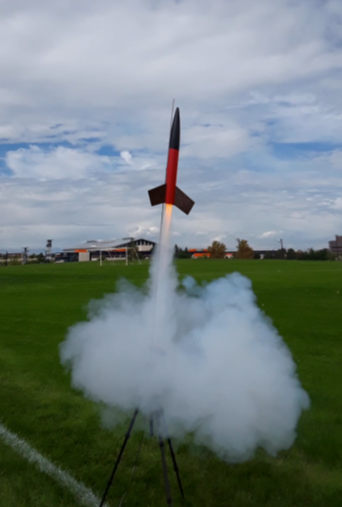 |
| With five A8-3's and two B6-4's blazing, the Mahogany Max roars off the pad for a low and slow flight. Ejection was at apogee, and the bird floated down for a perfect landing! |
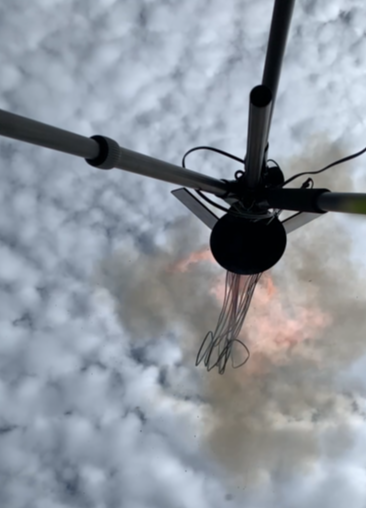 |
| A 'mole's-eye' view of the Max at ignition. Note the dispersion of the motor jet plumes as they hit the blast deflector. |
 |
| My Wasp boost/glider ready to go... |
 |
| A straight up boost on a 1/2A6-2 motor. The glider separated and flew very well. All was successfully recovered. |
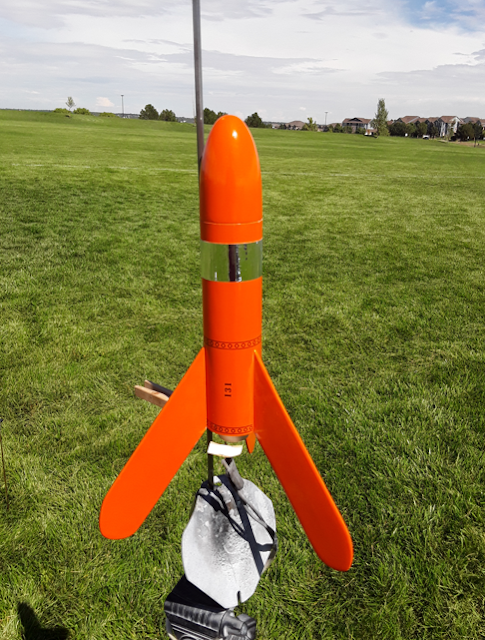 |
| Next up was my upscale Mosquito, the 'Skeeter Eeter 3'. Flying on a C11 motor the bird leapt off the pad and reached a respectable altitude. The model fell to the ground without a deployed parachute. |
 |
| To my amazement, the bird had stuck a perfect 3-point landing on its fins ! Step back, SpaceX !! The parachute can be seen jammed inside the nose cone. |
 |
| Darryl is seen here launching his Estes Goblin on a D12-5 motor while Lee and myself look on. The attractive bird turned in a spectacular flight! (Image by Brock Wood) |
 |
| Another view of the Goblin's liftoff. |
 |
| Apogee at around ten feet or so altitude.... |
 |
| ...and ejection on terra firma ! This flight was voted as the most amusing of the day! Fortunately, the ladies survived with no damage, and would see another flight very soon. |
 |
| Gosh, but I had so much fun launching the Interceptor earlier, I thought another run was in order. |
 |
| The start of another textbook flight on a C6-5 ! (Image by Brock Wood) |
 |
| Here we have Brock's 'Renewed Mongoose' two stager, ready to launch on a B6-0/A8-5 combo. |
 |
| Brock got this interesting shot of the model's liftoff from a video taken beneath the launcher |
 |
| ...and liftoff from a different perspective. The model turned in a perfect flight and was successfully recovered. |
 |
| Jim with his inverted-fin Alpha upscale and booster. This model was inspired by a design by 'Lakeroadster' in a TRF post. |
 |
| The unique booster stage is a ring fin design with cutouts designed to induce spin recovery. |
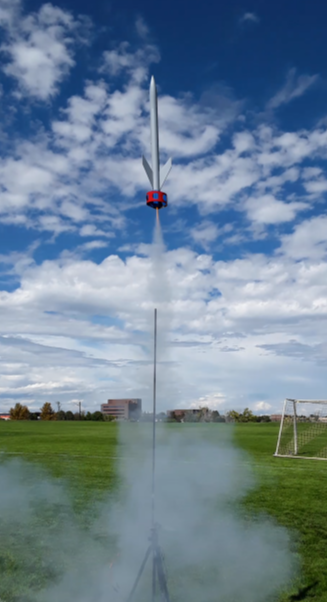 |
| Liftoff on a gap-staged D12-0 / C11-3 stack. The model weather-cocked and didn't get high enough to allow the booster to transition into a spinning motion. The upper stage sustained a broken fin on landing. |
 |
| Next up was Darryl's second launch of his ESAM-58 on a C6-5 motor. (Image by Brock Wood) |
 |
| A picture-perfect flight and recovery! |
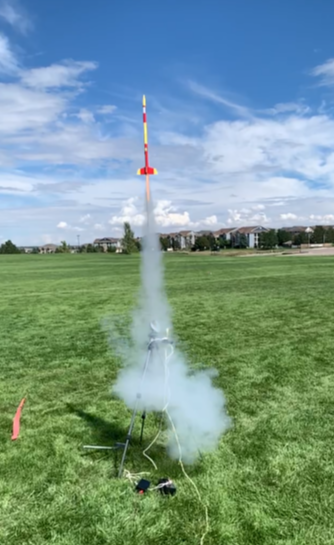 |
| The start of a perfect flight on a core A8-5 and an A10-0 in each of the side pods. |
 |
| Lee soon had his Bertha and Betty prepped and on the pad. This time the pair turned in a spectacular flight on two C6-3s. |
 |
| After a liberal amount of CA, Jim had his big two stager ready to go again. Flying on E12-0 / C11-3 power, the model turned in a much better performance. |
 |
| Here we have Brock's Custom Rocket Company 'Aztec' upper stage ready for flight. |
 |
| Liftoff for a great flight powered by a B6-4 motor. |
 |
| My final flight of the day was turned in by the Cherokee /Icarus 2-stager. Motors used were a D12-0 gap staged to a C6-7. The model carried an 808 video camera. |
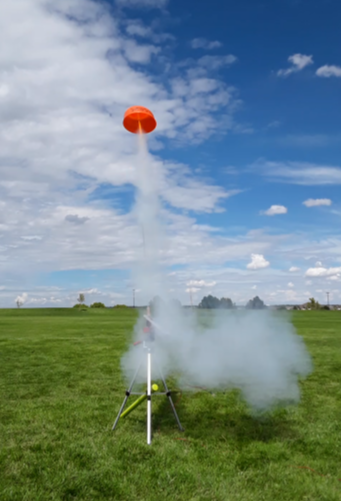 |
| The final flight of the day went to Lee's Halloween Bowl odd-roc. This time it was powered by a mighty E12-4 for a great flight! |
 |
| Guest Adam Wesorick from Castle Rock stopped by to enjoy watching a number of the flights. |
 |
| I happened to snap this photo of a cool looking thunderhead anvil forming off to the east of Denver. |
 |
| Two birds with one shot... This was taken from a frame of Brock's ground-view video of his Aztec flight. As the model neared apogee, a real bird flew into camera range right above the launcher! |
 |
| VERY old school ignition technology. All three of Brock's launches this day were started with ignitors fashioned from 28-gauge bare nichrome wire, looped and held in place with tamped wadding. Not a misfire in the lot ! Cheers! |












Excellent report! Were all the clusters using MJG BP starters? Can you tell me what a 'cluster controller' is? And do you happen to know how the 7 motor cluster was wired?
ReplyDeleteThe cluster controller is just my home-brewed, relay-controlled, 12 volt, sealed lead acid battery powered launch controller connected to two “whip clips”. Each whip clip has four igniter clips dangling off of it. The 12 volt, 9 amp-hour battery provides plenty of current to ignite clusters of rocket engines. The two whip clips make it convenient to hook up the controller to multiple igniters.
DeleteAs always, a superb blog post by Ed! I really enjoyed the flying. I want more Skeeter Eeter! I want more Canopus 2! Great birds!
ReplyDeleteI picked up a batch of vintage items years ago. A bunch of old payload sections and nose cones mostly, but also some vintage chutes, rod stand offs, and a bunch of the old nichrome wire igniters. Once I'm out of my funk, I think I'll give them a try.
ReplyDelete